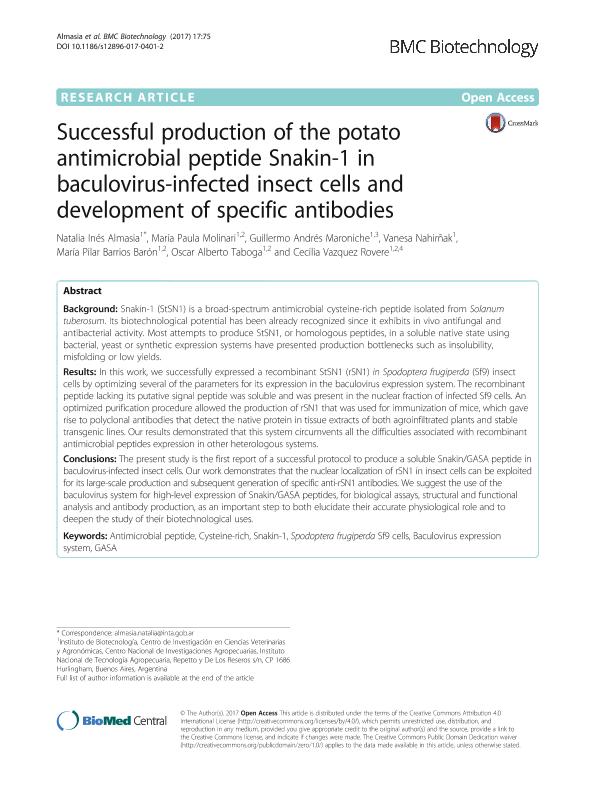Mostrar el registro sencillo del ítem
dc.contributor.author
Almasia, Natalia Ines

dc.contributor.author
Molinari, Maria Paula

dc.contributor.author
Maroniche, Guillermo Andrés

dc.contributor.author
Nahirñak, Vanesa

dc.contributor.author
Barrios Barón, María Pilar

dc.contributor.author
Taboga, Oscar Alberto

dc.contributor.author
Vazquez Rovere, Cecilia

dc.date.available
2018-04-23T19:01:18Z
dc.date.issued
2017-11
dc.identifier.citation
Almasia, Natalia Ines; Molinari, Maria Paula; Maroniche, Guillermo Andrés; Nahirñak, Vanesa; Barrios Barón, María Pilar; et al.; Successful production of the potato antimicrobial peptide Snakin-1 in baculovirus-infected insect cells and development of specific antibodies; BioMed Central; Bmc Biotechnology; 17; 1; 11-2017
dc.identifier.issn
1472-6750
dc.identifier.uri
http://hdl.handle.net/11336/43093
dc.description.abstract
Background: Snakin-1 (StSN1) is a broad-spectrum antimicrobial cysteine-rich peptide isolated from Solanumtuberosum. Its biotechnological potential has been already recognized since it exhibits in vivo antifungal andantibacterial activity. Most attempts to produce StSN1, or homologous peptides, in a soluble native state usingbacterial, yeast or synthetic expression systems have presented production bottlenecks such as insolubility,misfolding or low yields.Results: In this work, we successfully expressed a recombinant StSN1 (rSN1) in Spodoptera frugiperda (Sf9) insectcells by optimizing several of the parameters for its expression in the baculovirus expression system. The recombinantpeptide lacking its putative signal peptide was soluble and was present in the nuclear fraction of infected Sf9 cells. Anoptimized purification procedure allowed the production of rSN1 that was used for immunization of mice, which gaverise to polyclonal antibodies that detect the native protein in tissue extracts of both agroinfiltrated plants and stabletransgenic lines. Our results demonstrated that this system circumvents all the difficulties associated with recombinantantimicrobial peptides expression in other heterologous systems.Conclusions: The present study is the first report of a successful protocol to produce a soluble Snakin/GASA peptide inbaculovirus-infected insect cells. Our work demonstrates that the nuclear localization of rSN1 in insect cells can be exploitedfor its large-scale production and subsequent generation of specific anti-rSN1 antibodies. We suggest the use of thebaculovirus system for high-level expression of Snakin/GASA peptides, for biological assays, structural and functionalanalysis and antibody production, as an important step to both elucidate their accurate physiological role and todeepen the study of their biotechnological uses.
dc.format
application/pdf
dc.language.iso
eng
dc.publisher
BioMed Central

dc.rights
info:eu-repo/semantics/openAccess
dc.rights.uri
https://creativecommons.org/licenses/by-nc-sa/2.5/ar/
dc.subject
Antimicrobial Peptide
dc.subject
Cystein Rich
dc.subject
Snakin 1
dc.subject
Spodoptera Frugiperda Sf9 Cells
dc.subject
Baculovirus Expression System
dc.subject
Gasa
dc.subject.classification
Otras Biotecnología Agropecuaria

dc.subject.classification
Biotecnología Agropecuaria

dc.subject.classification
CIENCIAS AGRÍCOLAS

dc.title
Successful production of the potato antimicrobial peptide Snakin-1 in baculovirus-infected insect cells and development of specific antibodies
dc.type
info:eu-repo/semantics/article
dc.type
info:ar-repo/semantics/artículo
dc.type
info:eu-repo/semantics/publishedVersion
dc.date.updated
2018-04-09T15:06:34Z
dc.journal.volume
17
dc.journal.number
1
dc.journal.pais
Reino Unido

dc.journal.ciudad
Londres
dc.description.fil
Fil: Almasia, Natalia Ines. Instituto Nacional de Tecnología Agropecuaria. Centro de Investigación en Ciencias Veterinarias y Agronómicas; Argentina. Consejo Nacional de Investigaciones Científicas y Técnicas; Argentina
dc.description.fil
Fil: Molinari, Maria Paula. Consejo Nacional de Investigaciones Científicas y Técnicas; Argentina. Instituto Nacional de Tecnología Agropecuaria. Centro de Investigación en Ciencias Veterinarias y Agronómicas; Argentina
dc.description.fil
Fil: Maroniche, Guillermo Andrés. Consejo Nacional de Investigaciones Científicas y Técnicas; Argentina. Instituto Nacional de Tecnología Agropecuaria. Centro de Investigación en Ciencias Veterinarias y Agronómicas; Argentina
dc.description.fil
Fil: Nahirñak, Vanesa. Consejo Nacional de Investigaciones Científicas y Técnicas; Argentina. Instituto Nacional de Tecnología Agropecuaria. Centro de Investigación en Ciencias Veterinarias y Agronómicas; Argentina
dc.description.fil
Fil: Barrios Barón, María Pilar. Consejo Nacional de Investigaciones Científicas y Técnicas; Argentina. Instituto Nacional de Tecnología Agropecuaria. Centro de Investigación en Ciencias Veterinarias y Agronómicas; Argentina
dc.description.fil
Fil: Taboga, Oscar Alberto. Consejo Nacional de Investigaciones Científicas y Técnicas; Argentina. Instituto Nacional de Tecnología Agropecuaria. Centro de Investigación en Ciencias Veterinarias y Agronómicas; Argentina
dc.description.fil
Fil: Vazquez Rovere, Cecilia. Consejo Nacional de Investigaciones Científicas y Técnicas; Argentina. Instituto Nacional de Tecnología Agropecuaria. Centro de Investigación en Ciencias Veterinarias y Agronómicas; Argentina
dc.journal.title
Bmc Biotechnology

dc.relation.alternativeid
info:eu-repo/semantics/altIdentifier/url/https://bmcbiotechnol.biomedcentral.com/articles/10.1186/s12896-017-0401-2
dc.relation.alternativeid
info:eu-repo/semantics/altIdentifier/doi/https://doi.org/10.1186/s12896-017-0401-2
Archivos asociados
